Eaarth to Neo-Earth
It is blatantly obvious that We must go beyond realpolitik … Or ….
Realpolitik is now
What we previously called idealistic.
No! It wasn’t Kool-Aid!!
However, I did drink the earthy, healthy atole of awareness, hope, and action from the early progressive conservation movement of ca. 1890-1920, Vatican II, and pro-civil rights, anti-War, and pro-ecological-sanity sit-ins, marches, songs, poetry, speeches, articles, and books, and effective non-violent protesting (and lobbying and voting) of the 1960s-70s. A bit later the 1973 crisis in energetics spiked that wonderful elixir. And more recently the exponential accumulation of challenges of social injustice, inhumaneness, and ecological insanity of the Anthropocene here on this Eaarth2 have truly strengthened this ancient tonic which I both metaphorically and actually imbibe routinely.
One very hot afternoon in August when I was about ten years of age and struggling to mow my wealthier Uncle Peggy and Aunt Joe Bailey’s expansive lawn possessing steep and very difficult slopes, an extremely beautiful Carmelite nun from Mexico stopped and gave me a glass quart (Ball Mason jar) of cold refreshing “atole”. This young brown-and-white clothed angel was one of several who were teaching us catechism at St. Joseph’s Catholic Church that summer. They had been invited for supper into our very small two-bedroom home on the outskirts of Devine (for a family of eight) and the chilled “atole” was a gift for my family of eight. (“For my family!” Nevertheless, I quickly drank this unbelievably great manna from heaven all down my young gullet after la angelica floated away west on Highway 173 toward town & St. Joseph’s on that blistering sunny day.)
I am now in my 70s, my knees are stiff and don’t function as they once did. At times I feel really miserable up in the afternoon or when I get out of bed in the morning, and especially after long car trips (or working for long periods on este procesador de textos y máquina de búsqueda de google). But I do regularly become refreshed and recharged by atoles of very adorable and knowledge-seeking youth with whom I learn about PEACE1 and kid around with–through NGOs like Kids on the Land, Generations Indigenous Ways on Pine Ridge Reservation, Dos Pueblos (Arco Iris) in Nicaragua, Ogallala Commons, the Seguin Outdoor Learning Center, HEB camps on the Frio River, Seguin community gardens and especially the LULAC garden, and Episcopalian service efforts in Honduras & Mexico … as well as in family gatherings with my beautiful grandkids.
The primary reason for this little book of PEACE1, is that I want to bring us back from Eaarth to Earth, and to provide for some of the youth of the world some of the dynamic homeostatic symbioses, or “nature”, which I was able to learn about and thoroughly experience in my own lifetime. I fervently wish to have a small part in helping to leave a world system of quality life for all, including other species, for as long as possible
My life experiences and academic learning with respect to realizing sustainable community have primarily been in agriculture and biology3. And much of my academic learning has focused on agricultural entomology. Although I can communicate “Scientifically” to some degree, I do prefer relating personal stories to make my “scientific” points in a socio-economic/political and psychological (i.e., ecological) context about sustainability. Personal anecdotal situations in which I have been that have a sustainability message of needing to persevere and to live wisely and humbly and in a giving way include:
• A plethora of warm (and not so warm & fuzzy) tales from a five-acre diversified hog farm of the Alton and Louise Martin family in a south Texas ecosystem
(near where the transnational Wal-Mart and other businesses now cover an area which was mostly photosynthesizing pasture; these largely parasitic structures slickly market stuff which isn’t appropriate for realizing sustainable community).
• My brothers and I burying numerous of my uncle’s hogs which had died of cholera in his relatively large and more artificial swine facility in the 1960s.
• Wrecking a semi-trailer truck near Premont, Texas, twice in one night, after a long & hurried haul of black-eyed peas from the Winter Garden area of south Texas to a Brownsville cannery in the Lower Rio Grande Valley.
• Going to the state meet in the 440-yard dash … definitely not because of athletic ability or disciplined & rigorous training, but as a result of persistence (and substantial luck).
• Almost passing away in an avalanche of cottonseed hulls in a poorly lit, hustle and bustle of feed mill in my hometown (pre-OSHA).
• Killing three beautiful large male boars my Dad had recently bought in the Pearsall area to rapidly finish out and take to the Swift & Co. slaughtering plant in San Antonio; they died because of rushed castrations.
• Coming close to dying in cotton insect research plots in the Brazos Bottom from the very toxic, cholinesterase-inhibiting biocide, aldicarb, ultimately produced through groupthink and callous transnational corporations (There were other near-death experiences. My Mom says I am a cat with nine lives who has used up most of them.). [I also have stories about inappropriate technology and engineering from chemists, biologists, agriculturists involving persistent chlorinated hydrocarbons, neurotoxins, and other biocides … and the hormone-mimics in Agent Orange, etc.]
• Religious and military experiences in the 1960s and my sort of ignostic-psyche as influenced by this period and my Marine Master Sergeant-dad and through being in a Catholic-Protestant family pre- and post-Vatican II.
• Screwworm, lacewing, tobacco budworm, and boll weevil micro-evolution.
• Loss of fields laden with beautiful green beans grown in a high energy-input way in the Winter Garden of Texas (lost to weather because the inability of big machines to traverse through wet fields).
• “Unusual” (but natural), sort of quiet, secretive, “subversive” damage to popcorn near Pearsall, Texas by fall armyworms.
• Devastation of non-sustainable monocultures of coastal bermudagrass in the SE U.S. and Brachiaria in far western Brasil by fall armyworms and spittlebugs.
• My Don Quixote-type protests against the greasing of the path for non-sustainable, high-input industrial agrilogistics by Land Grant universities.
• Many stories of the suffering, exploitation (including sexual), and perseverance of recent brown-human immigrants in Texas, U.S.A., or those seeking to immigrate.
• Experiences on the Sugar Land Texas prison farms and seeing the brown & black de facto slaves work the fields while white trustees on horseback with guns looked over these imprisoned field laborers. I was there as an entomology student-worker as a result of biocide-resistant tobacco budworms eating up their cotton and subsequent USDA band-aid-type research done for transnational corporate profits.
• Las aguas prietas de imperialismo (Coca-Cola) at the Colegia Superior de Agricultura Tropical, Cardenas, Tabasco, Mexico.
• Land reform and the mosaic of Roberto Strang’s fazenda in the Mato Grosso do Sul, Brasil,
• A month of work in a community garden in Krakow, Poland which changed dramatically after the Wall fell … and involvement in other community gardens.
• Gifts of caps, meals, and fishing and hunting trips, and campaign donations mostly from large transnational corporations—power3 and quid pro quo corruption at Land Grant institutions, experiment stations, and regulatory agencies, including my own failings (Oh come on … you too have experienced some of this!).
• Stories of the powerful and not so powerful during my period as a farmer-stockman in south central Texas.
• Because of non-adherence to the Precautionary Principle, toxins from old tick-control dipping vats within the Alamo Ranch subdivision, SA, military bases , drenching of nursery products to combat fire ants, chemical spills at the Devine Municipal Airport, etc. … exist and persist in our soils and water.
• Many other stories, primarily from Texas, which pop into my head and come forth from my boca to make a point about needs for and ways of achieving sustainable community.
These stories deal with human overshoot of carrying capacity, drawdown on the natural resource base, and the tremendous disparity and poverty in the world. They underline the need to live the 7 Ss which means individually- and collectively-living: Sabiamente (Wisely), Simply, Smally, Slowly, Steadfastly, Sharingly, Sustainably. These tales point out the need for a dramatic leveling off of growth of populations of humans and domesticated biota and reduction of consumption by the Haves, as well as a gracious sharing of the power3 of the Haves with the havenots of Eaarth (including other species).
I will be employing some of these short stories herein this little book.
Embodied-Human Appropriated Net Primary Productivity.4 Back in the late 1980s/early 1990s I had some brief and uncomfortable arguments with cantankerous (but very intelligent, clairvoyant, and focused) Allan Savory and some of his “Holistic Resource Management”5 disciples about planned-controlled-grazing (which is a good tool for consideration and employment in sustainable systems), Allan’s set-in-concrete “rules and taboos”, and some of his dogma. Nevertheless, I sincerely and deeply appreciate Allan for helping me think more holistically about what I now mostly call PEACE1 and the need for developing clear goals and a strategic plan of action. (And I have tried to explain some of what I gathered from Allan in several papers/publications to which I have contributed.)6
Allan emphasizes the importance of monitoring and replanning after actions toward sustainable community. If you don’t have sustainable measures of sustainable community and ecosystem assessments, then you are mostly living in the dark and are not going to reach profound and holistic quality life for all for a truly significant period. Later in this little book we will present a taxonomy of sustainable indicators which can assist in realizing a goal of sustainability for all, i.e., social justice, humaneness, and ecological sanity.
However, in this introduction, I would like to focus on what is perhaps THE key indicator which should be monitored in order to travel toward sustainable community and a neo-Earth, i.e., embodied Human Appropriated Net Primary Productivity (eHANPP). It is basic, holistically profound and comprehensive, and an indicator for determining if your livelihood and lifestyle is socially just, humane, ecologically sane, i.e., sustainable; moral and ethical.
As with many sustainability indicators, quantifying eHANPP somewhat precisely and accurately is generally complicated and difficult. However, eHANPP data can provide a composite focus on the impact humans and various sectors of human populations are having on the natural resource base and on life systems which are conducive to quality life for humans and associated life forms.
Units for energy are joules (or one could convert joules to calories or British Thermal Units/BTUs). Moreover, remember from your biology7 classes or general reading, listening, and viewing, that …
life is matter (carbohydrates, lipids, proteins, nucleic acids, cells, populations, communities, etc.) organized with inputs of energy (or calories).
And for the most part energy to run the world (Nature’s Economy and its subset, the Human Economy) is from daily solar energy and the daily solar energy of the past, i.e., savings-in-the-bank which we call fossil energy. Daily solar energy is mostly transformed into a useable form by what are for the most part the only real producers on Earth, or Eaarth, i.e., plants and other photosynthesizers.
What these unique producers (plants, autotrophic protists, chromists, and blue-green algae) capture in terms of energy in a particular area, in an ecological community of biota, in an ecosystem, or across the landscape of a nation or an ecosystem is called primary productivity (PP). PP could be expressed as energy; however, since photosynthesizers are capturing solar energy in chemical bonds of chains of carbon (which is biomass), scientists generally measure carbon, biomass, or dry plant matter to estimate PP.
The PP left over after the cellular respiration, metabolism, maintenance, and propagation needs are met for the photosynthesizers (or “plants”) is termed net primary productivity, or NPP. NPP can be utilized by heterotrophic organisms like bacteria, heterotrophic protists, fungi, or animals such as humans or their domesticated carnivores up the food chain or trophic levels.
On Eaarth, or in the Anthropocene, humans get the lion’s share of NPP. If human actions result in harvesting large amounts of food for humans and their pets, extensive areas of pavement, plowed fields and non-native vegetation, over-grazing & -browsing, clear-cut forest-Land, and excessive built structure, exorbitant amounts of NPP are appropriated for human use (HANPP) and PP and NPP can be diminished. Moreover, in order to construct the machinery and provide other inputs for paving, constructing, fencing, sawing and logging, etc., materials are appropriated from the targeted Land areas as well as from other parts of the globe over periods of time (eHANPP).
What I would encourage you to do now is to take a minute and walk out across your local landscape and view the amount of paved area, extravagant homes, business structures, automobiles, plowed fields, pastures with cattle, other grazers and perhaps browsers, and/or deforested area. Now think about how the local human population is affecting NPP. Despite (and sometimes because of) the Endangered Species Act, CITES, EPA regulations and Superfunds; WWF, Greenpeace, the Nature Conservancy, the EDF, the NRDC, the Tuskegee & Land Institutes, old LISA & more recent “modified-LISA” USDA initiatives, the Gates, Buffett, Kellogg, Ford, Rockefeller Foundations, and Master Naturalist programs, “organic” agriculture, “renewable” energy development, innovative “sustainability” entrepreneurs, etc., etc., etc. … we continue to rampantly increase our appetite across the globe for NPP, with end results of there being little of the life-giving NPP for the relatively powerless, impoverished, landless, and disenfranchised (undocumented; refugees), or poor humans and other species.
For full disclosure, I do wish to say that inputs of fossil energy and limiting factors such as water and key minerals (N, P, K, S, Fe, etc.) can increase PP and NPP. However, these local or regional actions generally affect global PP and NPP detrimentally and/or can change the globe such that it is not conducive to quality life for humans, and biota associated with humans (i.e., resulting in: loss of productive water-sheds/natural foodsheds; dead zones at the mouth of major rivers, especially in the developed, very industrialized parts of the world; global climate change; acidification of the ocean; bleaching of coral reefs; etc.).
Moreover, I need to emphasize herein that there are many sustainability indicators and ways of assessing sustainability in addition to eHANPP which have been proposed by various psychologists, socio-political/economic researchers and other ecologists, i.e., scientists studying various aspects of PEACE/Positively Ethical Applied Community Ecology8.
It is just that I consider eHANPP to be the key indicator for staying on track toward sustainability for all.
Now … even though we will deal with appropriate actions toward sustainable livelihoods and sustainable community in illustrations and other narrative in this book, let’s give some thought at this point to:
What are major actions we can take to reduce eHANPP?5
1. Learn about PEACE principles, processes, and values through PEACE1,8 across curricula and campuses of all human organizational entities.
2. Learn to curb our appetite for stuff and inappropriate kinds of and excessive amounts of food, fiber, shelter, travel/transport, conventional air-conditioning, information, electronics, technology, engineering, recreation and entertainment. … Food is the largest component of your ecological footprint. Compost and raise your own food. Eat local. … Primarily walk, use a bicycle, and travel by train & bus. … Wean yourself from air-conditioning, large home, and automobiles. … Try to never travel by car simply to “go & exercise”.
3. Cut manufacture of armaments, arms, and military spending.
4. Regulate in various ways toward curbing consumption.
5. Tithe+ and share with the truly poor in the world.
6. Reparate, give welfare & health care assistance, and “act affirmatively” when we should. And realize Land reform. … Remember, if it doesn’t work for the poor, it isn’t sustainable.
7. Seriously consider capping income and curbing the accumulation of capital/assets. If we have power3 over people and resources (or NPP) we’ll use it. If we don’t … we won’t!
And now I reiterate:
If it doesn’t work for the poor it isn’t sustainable.
If we don’t have an excess in power3, we won’t be able to use it excessively.
If we don’t … we won’t!
…………………………………………………………
This little book on PEACE1 is not so-much about the insurmountable (even though challenges exist which may seem so) and the Catch-22 Human Economy (even though this exists). It calls for a much needed “idealistic” realpolitik. It is a grito “de ¡Si Se Puede!” which deals with the Why?? What? And How??? of the process, or of our journey, primarily by utilizing illustrations, poetry and short stories.
• The Why?? is basically that an ethic of reciprocity is a major tenet in all of human spirituality, in human secularism, and in the various religions. Moreover, the drive in all species of biota is to maintain the species in suitable symbioses and to not go extinct.
• The What? is to live sabiamente, simply, smally, slowly, steadfastly, sharingly, and sustainable in a socially just, humane, and ecologically sane way. Currently we need to level off our human and domesticated species populations, and the Haves must share their power3 with the poor, disenfranchised, and relatively powerless.
• And the How??? begins with PEACE1 across “curricula” and “campuses” of all human organizational entities.
My plea to you in this moment and others is to please read, cogitate, seek out and learn about principles & processes of ecology, advocate, protest, lobby, VOTE!!!, agitate, and take appropriate actions toward sustainable livelihoods and a neo-Earth for all.
**************************
1 A possible introduction to PEACE*: Embracing a Profound and Holistic Process for Good (A Heavily Illustrated Little Book on Applied Ecology for Kids from 12 to 120 Years of Age). *PEACE is “Positively Ethical Applied Community Ecology.” [I am continuing to work and post pieces of a first draft and will do more word-processing and editing over the coming months. Then I hope to have a copy of a draft ready for some major outside editing and possible publication in the “near” future.]
2 Eaarth is a Bill McKibben term for the currently carbonized and otherwise ecologically-challenged version of what was a relatively healthy home for Homo sapiens and associated life-forms before the Anthropocene, i.e., Earth. http://billmckibben.com/eaarth/eaarthbook.html
3 The ability to produce an effect, but also energy/time measured in watts.
4 I must thank Helmut Haberl for this. He very, very graciously sent me numerous publications when I learned of his work through a colleague researching ecosystem energetics at the Land Institute while I was working with two St. Philip’s College students at the Department of Energy lab, Richland, Washington through an NSF grant . I hope I haven’t disappointed Helmut with my relatively weak efforts herein. https://www.aau.at/en/social-ecology/team/haberl-helmut/
5 https://en.wikipedia.org/wiki/Allan_Savory
https://www.context.org/iclib/ic25/wood/
6 Martin, P.B. and P. Prather. 1991. Sustainable agriculture: a process at the community level. American J. of Alternative Agriculture. 3(1)
Martin, P.B., K. Schantz and P. Sechrist. 2003. Toward conservation and development of sustainable community (locally and globally). Proc. Coloquio Internacional de Desenvolvimento Local, Universidade Catolica Dom Bosco, Campo Grande-MS, Brasil www.ucdb.br/coloquio/arquivos/Paul.pdf
Martin, P.B. and P. Prather. 1991. Towards a sustainable agriculture for quality life and protection of the natural resource base. Proc. 2nd Agroforestry Conference, Aug 18-21. Columbia, MO
Abel, A., P. Prather and P.B. Martin. 1992. Sustainable agriculture and migrant farmworkers. J. Sustainable Agriculture 3(1): 99-106
7 The study of life, or of learning about all which is truly important to us.
8 Humble but robust search for means of ethically understanding appropriate relationships of biota and the physical environment.
*********************************
pbm
[ 7 Ss / VV->^^ ]
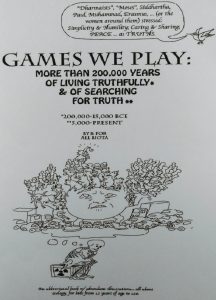
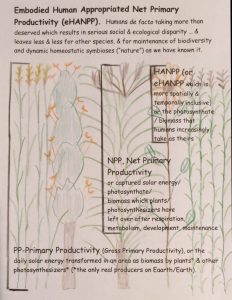
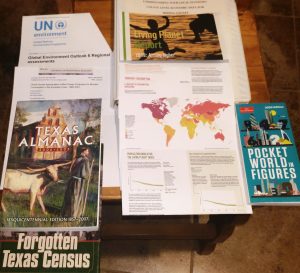
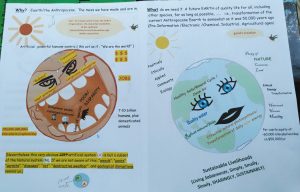
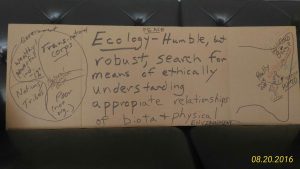
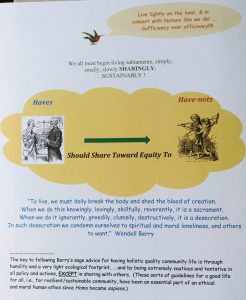
Thanks Paul, great intro. Keeping it real !
Thanks much Celeste!